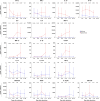Effect of Severe Fever With Thrombocytopenia Syndrome Virus Genotype on Disease Severity, Viral Load, and Cytokines in South Korea
- PMID: 39310272
- PMCID: PMC11414404
- DOI: 10.1093/ofid/ofae508
Effect of Severe Fever With Thrombocytopenia Syndrome Virus Genotype on Disease Severity, Viral Load, and Cytokines in South Korea
Abstract
Background: Severe fever with thrombocytopenia syndrome (SFTS) is an emerging tick-borne disease caused by Bandavirus dabieense (SFTS virus [SFTSV]). Recently, at least 6 different genotypes of SFTSV have been identified, with genotypes A, D, and F dominant in China and B dominant in Japan and Korea. This study investigated the effect of SFTSV genotypes circulating in South Korea on disease severity, viral load, and cytokine profile.
Methods: We prospectively enrolled 70 patients with SFTS from July 2015 to June 2022. Serial plasma samples were obtained during hospitalization and analyzed. Viral load was measured by real-time reverse-transcription polymerase chain reaction. Partial sequences of the viral genome were analyzed for genotyping. Plasma concentrations of 17 cytokines were measured by multiplex-bead immunoassay.
Results: Of 70 samples, 51 could be genotyped. Genotype B was predominant (80.4%) and other genotypes were uncommon. Intensive care unit admission rates (51.2% vs 50.0%) and mortality rates (26.8% vs 40.0%) did not show any significant differences between genotype B and non-B genotypes. The initial viral load did not show any significant differences (3.59 vs 3.64 log copies/μL), whereas viral load measured at hospital day 3-4 tended to be higher in genotype B than non-B genotypes (3.83 vs 1.83 log copies/μL, P = .07). Additionally, the plasma concentrations of interferon-α, interleukin 10, and interferon-γ-induced protein 10, which are closely related to mortality in cases of SFTS, did not show any significant differences.
Conclusions: SFTSV genotype B was the prevalent genotype in South Korea, with no genotype-specific difference in clinical outcomes, initial viral load, or cytokine profiles.
Keywords: SFTS; cytokines; genotype; severe fever with thrombocytopenia syndrome; viral load.
© The Author(s) 2024. Published by Oxford University Press on behalf of Infectious Diseases Society of America.
Conflict of interest statement
Potential conflicts of interest. All authors: No reported conflicts.
Figures




References
-
- Choi E, Lim A, Kang HJ, et al. Genotype analysis of severe fever with thrombocytopenia syndrome virus detected in patients. Public Health Wkly Rep 2021; 14:597–606.
-
- Choi J, Hwang JH, Lee H, Hwang K. Epidemiological characteristics of cases and deaths of severe fever with thrombocytopenia syndrome (SFTS), 2022. Public Health Wkly Rep 2023; 16:1025–37.
LinkOut - more resources
Full Text Sources

